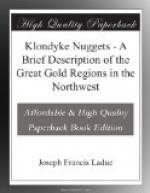“Between White and Stewart Rivers, ten miles, the river spreads out to a mile and upwards in width, and is a maze of islands and bars. The survey was carried down the easterly shore, and many of the channels passed through barely afforded water enough to float the canoes. The main channel is along the westerly shore, down which the large boat went, and the crew reported plenty of water.
“Stewart River enters from the east in the middle of a wide valley, with low hills on both sides, rising on the north sides in steps or terraces to distant hills of considerable height. The river half a mile or so above the mouth, is two hundred yards in width. The current is slack and the water shallow and clear, but dark colored.
“While at the mouth I was fortunate enough to meet a miner who had spent the whole of the summer of 1887 on the river and its branches prospecting and exploring. He gave me a good deal of information of which I give a summary. He is a native of New Brunswick, Alexander McDonald by name, and has spent some years mining in other places, but was very reticent about what he had made or found. Sixty or seventy miles up the Stewart a large creek enters from the south which he called Rose Bud Creek or River, and thirty or forty miles further up a considerable stream flows from the north-east, which appears to be Beaver River, as marked on the maps of that part of the country. From the head of this stream he floated down on a raft taking five days to do so. He estimated his progress at forty or fifty miles each day, which gives a length of from two hundred to two hundred and fifty miles. This is probably an over-estimate, unless the stream is very crooked, which, he stated, was not the case. As much of his time would be taken up in prospecting, I should call thirty miles or less a closer estimate of his progress. This river is from fifty to eighty yards wide and was never more than four or five feet deep, often being not more than two or three; the current, he said, was not at all swift. Above the mouth of this




